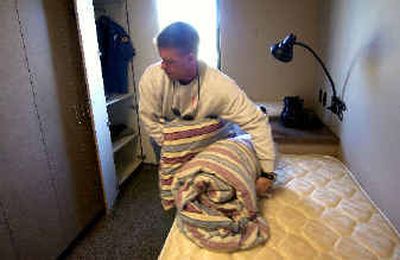Valley Fire gets new digs

Spokane Valley firefighters can sympathize with college students who have recently moved into dorms and started classes.
Crews began responding to emergencies from three new locations Tuesday while also getting used to their new living spaces.
Firefighters at the roomy Station 8 unpacked equipment, set up sleeping quarters and stocked the kitchen. The stove wasn’t hooked up yet. The kitchen table was under construction. A gas grill still had the price tag affixed to the front.
The Station 8 crew – between settling in – had gone on two calls by noon Tuesday.
The other two stations that opened Tuesday are small renovated homes. They have two-member paramedic crews that will go on medical calls, particularly those requiring advanced medical training.
The Spokane Valley Fire Department had not added a station since 1994. Valley Fire hopes the stations will decrease the amount of time it takes firefighters to get to both fires and medical emergencies, said Valley Fire Commissioner Joe Dawson.
Station 8, at 2110 N. Wilbur Road, near large apartment complexes, retirement homes and a business corridor, is expected to be one of Valley Fire’s busiest. Valley Fire has 150 full-time firefighters and responded to more than 8,000 fire and medical emergencies in 2003. It serves nearly all of Spokane Valley as well as Liberty Lake and unincorporated areas like Otis Orchards.
Except for a common not-yet-lived-in look, the three stations could not be more dissimilar.
Station 8 cost $1.4 million to build and has space for three firetrucks. Station 9, a remodeled rancher on East Sixteenth Avenue near South Bowdish Road, has wood floors and a fireplace. Station 10 at 17217 E. Sprague Ave. was a sales office for manufactured homes and has plush green carpet and frilly curtains. The remodeling costs for the two houses were expected to be $300,000.
Station 8 sits just to the north of Interstate 90 along the Union Pacific railroad tracks. Currently, only one three-member crew will work from the station, which has 13,000 square feet including the basement and an upper level.
Firefighters helped design the station and suggested small things they thought would make life easier. It has durable, easy-to-wash floors and a stove that switches off automatically if firefighters get sent to a call. A grate in the concrete floor of the bay area where the trucks are kept encloses a narrow concrete area where firefighters can practice trench rescue techniques and confined space drills.
Firefighters helped save money by telling the administration things they didn’t need, Rider said. Consequently, concrete blocks were left exposed on interior walls. There are unfinished ceilings in some of the storage rooms and doors were left off when not needed, Rider said.
The two paramedic stations are the first of their kind in this region.
Initially, the union fought the “medic house” idea, saying that their contract called for stations with firetrucks. The issue was eventually settled during contract negotiations.
Valley Fire Commissioner Monte Nesbitt, a retired Valley firefighter, said he supports the idea of the medic stations, but said he’s waiting to see if they decrease response times before making a final judgment. Paramedics could be tied up attending to something like a broken leg when they’re really needed at more life-threatening situations, such as heart attacks. The paramedic stations are supposed to be temporary fixes until Valley Fire has the funds to build and staff permanent stations near the locations, commissioners have said.
Several miles to the south of Station 8, paramedic Station 9 sits on residential East 16th Avenue. Jeff Smetzler, a paramedic trainee, was at the station Tuesday working to get it set up.
“The big thing we’ve talked about at this station is being a good neighbor,” Smetzler said.
Valley Fire commissioners approved a $6,000 white fence to shield the neighbors from the station’s back parking lot.
Stormy Kasparian, who has lived in the neighborhood more than 15 years, said that as long as firefighters make good on their promise not to “blast the neighborhood” with their emergency sirens, they’ll be a good addition. She hopes their presence will increase property values as she plans to sell her house in the near future.
“The more paramedics we have, the better,” Kasparian said.